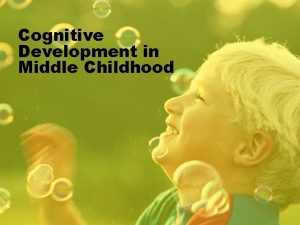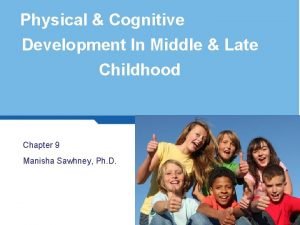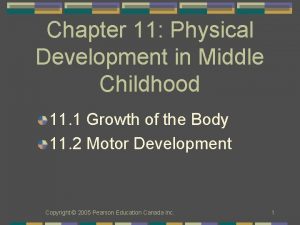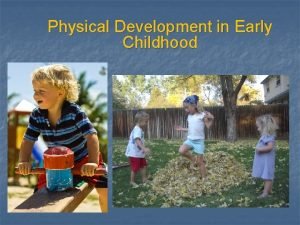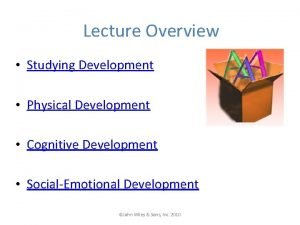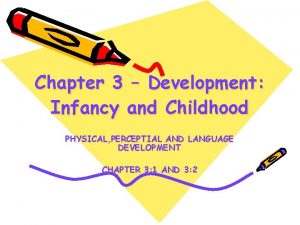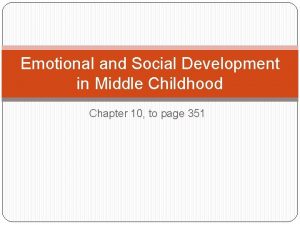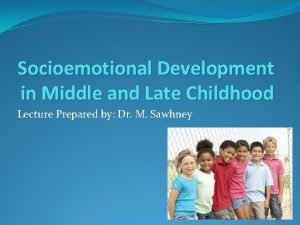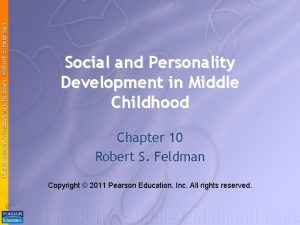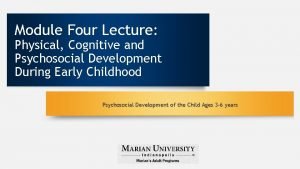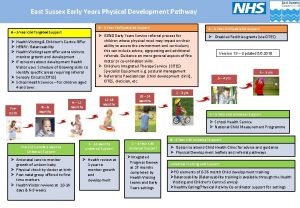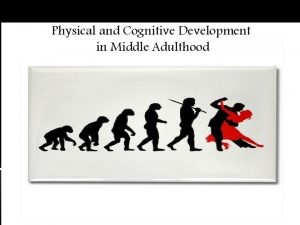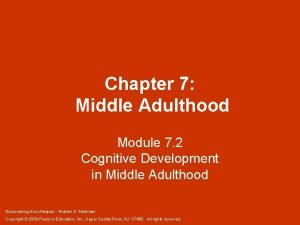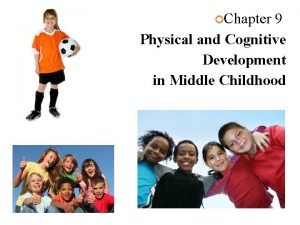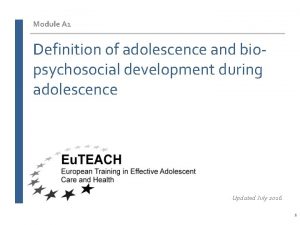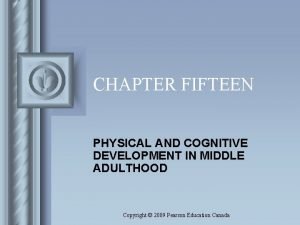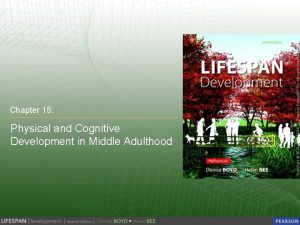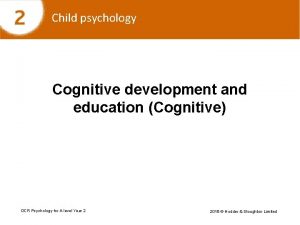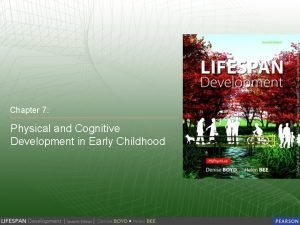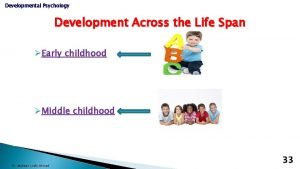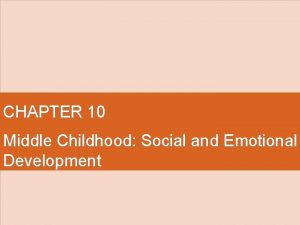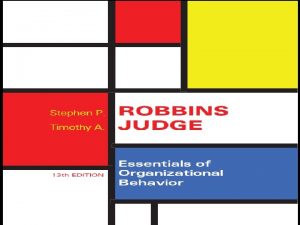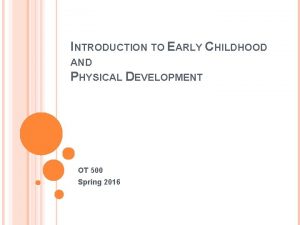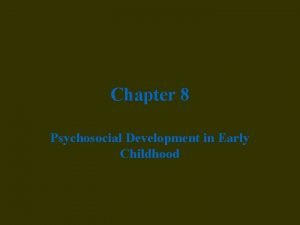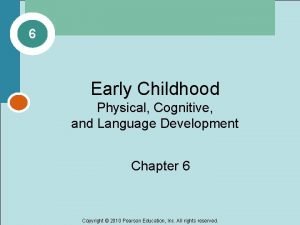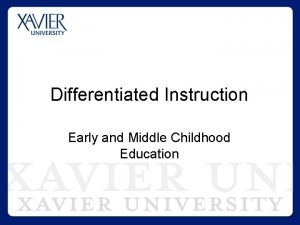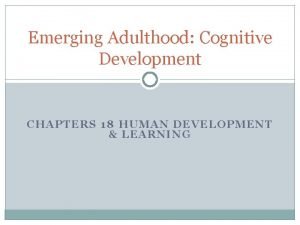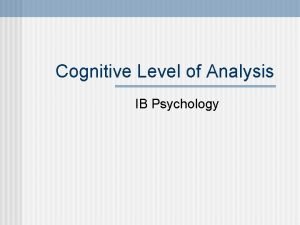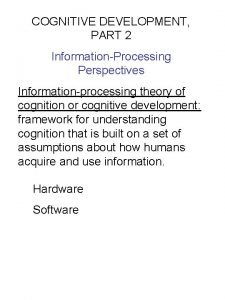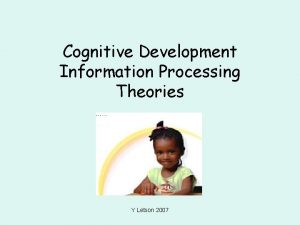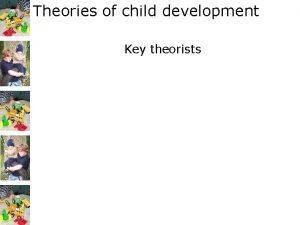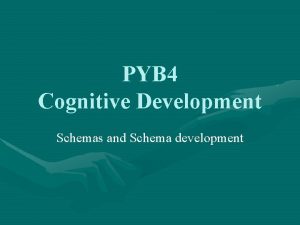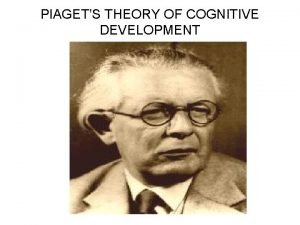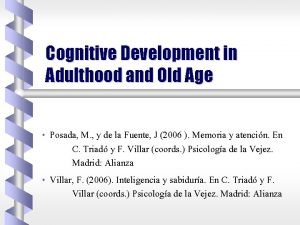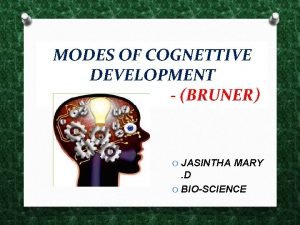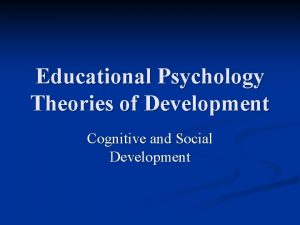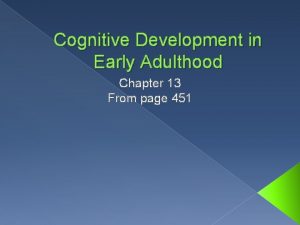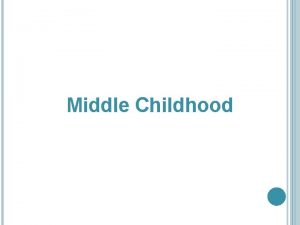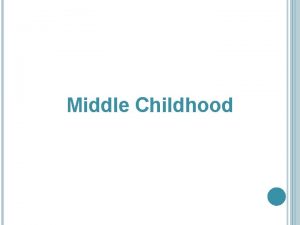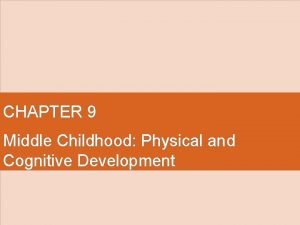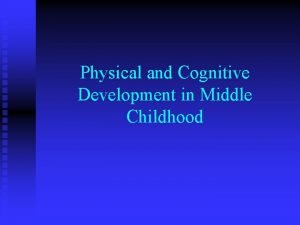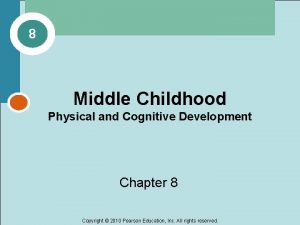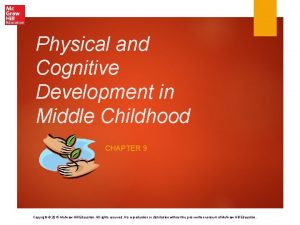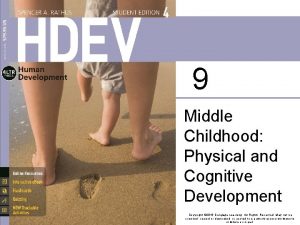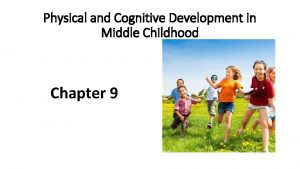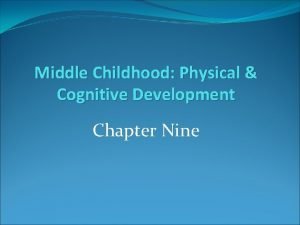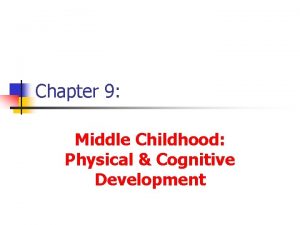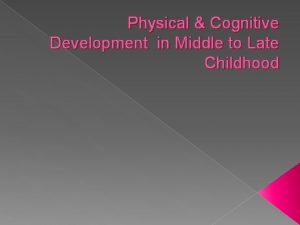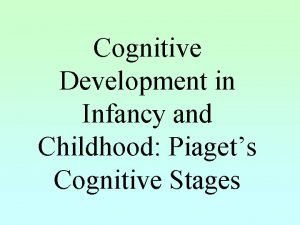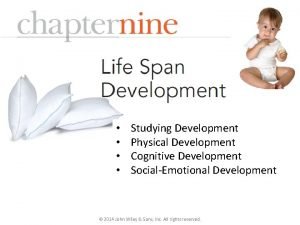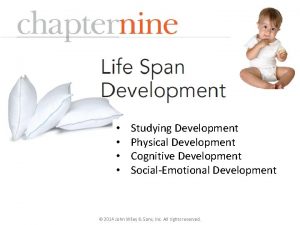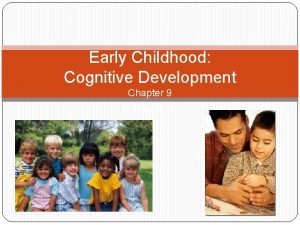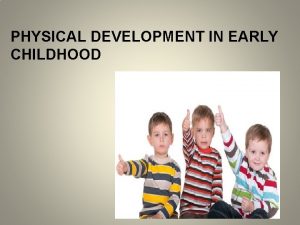Middle Childhood Physical and Cognitive Development in Middle































































- Slides: 63

Middle Childhood

Physical and Cognitive Development in Middle Childhood

Obesity Obesity: Prevalent in children, mostly ages 6 to 11 6 -year-old has 25% risk of being obese adult 12 -year-old has 75% risk of being obese adult Linked to lack of exercise A risk factor for other medical and psychological problems Low self-esteem, depression, and teasing by peers are common Today, too much time is spent watching TV, on computers, and playing video games. Obese children are less active and more sedentary Context in which child eats can influence eating habits and weight Children who eat meals with their families have better nutrition Eating while watching TV is implicated; high fat, high sugar, low nutrition snacks are advertised and eaten

Percentage of U. S. Children in Daily Physical Education Programs from 1969 to 1999 80 Percent of children involved in daily physical education programs 70 60 50 40 30 20 10 0 Fig. 10. 1 1969 1979 1989 1999

Sports More children become involved in sports every year; communities and schools are offering more sports programs 60% of boys and 40% of girls participate Sports participation has both positive and negative effects concerns about pressure to win and exploitation More of children’s sports participation is formal and adult supervised than in previous decades Child created games are less likely to be contests of skill and have higher element of chance, provide practice and exploration of skills as well as rules and social skills What are the potential benefits and risks associated with this?

POSITIVE SPORTS FOR KIDS Focus on skill development, teamwork, sportsmanship, social aspects and having fun Age appropriate skills, training, and safety equipment to prevent injuries including overuse related injuries Supportive, nurturing and encouraging coaching and context Play time based on attendance at practice rather than skill Monitor pressure and competitiveness and intervene quickly to reduce violence Reduce barriers for children with weight problems and disabilities and low SES

Disabilities Approximately 10% of U. S. children have a disability (learning disability, mental retardation, serious emotional disturbance) and receive special education or related services. More than 40% of these have learning disabilities Learning disability has 3 criteria: Exclusionary criteria IQ–achievement Specificity discrepancy of learning problem

Law and Special Education 1970 s: Laws passed requiring all public schools to serve disabled children 1975 Public Law 94 -142, was renamed Individuals with Disabilities Education Act (IDEA) in 1990 Law requires disabled students receive IEP: Individualized education plans LRE: Least restrictive environment setting Inclusion in full-time, regular classroom

U. S. Children with a Disability Who Receive Special Education Services (2001 -2002)

Learning to Read This is a major accomplishment early in Middle childhood Builds on emergent literacy such as concepts about print, phonemic awareness, rhyming. Etc. Children learn much more readily in a print rich environment Parents who read for pleasure and regularly read to and with children have offspring that learn reading more quickly and enjoy reading more

The Relation of Reading Achievement to Number of Pages Read Daily 240 230 220 210 Average reading score 200 190 180 170 0 5 or fewer 6 to 10 11 or more Number of pages read daily

2 Major methodologies Whole language Children are taught sight words and how to use context clues, while reading real literature Based on research showing that good readers extensively use context clues and children enjoy reading more when they read “real” literature Phonics Approach Children are taught to sound out words and even nonwords in Frequent phonics drills Modern research strongly indicates that this is essential, especially for struggling readers Both can be helpful but ALL good readers must learn phonics

Cognitive Development

Piaget and Concrete Operations Concrete operations are reversible Children begin to understand that an action can be undone by another action They also learn that on aspect can compensate for an other (a width for height or distance from a balancing point for weight) Children can look at two properties together Also begin to express mixed emotions Also recognize that things can fall into multiple categories Begin to focus on transformations as opposed to states alone

Concrete Operations 3 Categorization becomes more advanced Children develop greater flexibility in categorizing and develop more complex hierarchies Children are now able to succeed at class inclusion problems

Concrete Operations 2 Children can follow simple diagrams and tables Categorizing abilities improve and they can more readily switch criteria and multiple possible criteria Seriation- the ability to order things along a quantitative dimension

Concrete Operations 3 Transivity –using information about relations to from conclusions A<B B<C then A<C A B C Younger children must make all comparisons to solve these problems Older children can follow the logic 7 -8 year –olds can do this with help remembering the relations

Concrete Operations 4 Increased ability in spatial reasoning Mapping ability Creation and use of maps improves Giving adequate directions improves Preschool, early school age Landmarks Ages 8 - 10 Landmarks along organized route of travel End of middle childhood Overall view of large-scale space

Neo-Piagetians suggest more emphasis on how children process information Case suggests gains are due to automation of schemes freeing resources to develop new schemes or combine schemes During middle and late childhood Information processing changes include memory, metacognition, and critical and creative thinking Short-term memory increases quickly before age 7 Increases from 4 to 7 items from age 7 to age 12 Long-term memory increases; expertise depends on learning activities and strategies used

Information Processing Gains in Middle and Late Childhood Increases in processing speed and memory capacity More resources available for problem solving Gains in inhibition/effortful control Helps in focus of attention and planning which also increase Greater use of memory and problem solving strategies Elaboration, organization Greater metacognitive abilities Still struggle with cognitive self-regulation- continually checking progress toward a goal Parents and teachers can promote this which in turn increases academic self-efficacy

Intelligence Intelligence: problem-solving skills, ability to learn, speed of processing Usually broken into verbal (oddly it includes math) and performance Crystallized intelligence - knowledge and application of knowledge Fluid intelligence – general ability to adapt and learn

IQ Tests Intelligence tests: Binet Tests (early 1900 s): IQ is MA divided by CA and multiplied by 100 Stanford-Binet tests approximate a normal distribution—a bell-shaped curve. Wechsler Scales: 11 subscales, 6 verbal, 5 nonverbal WPPSI-R: ages 4 to 6. 5 years WISC-III: ages 6 to 16 years WAIS-III: adults

The Normal Curve and Stanford-Binet IQ Scores

Sample Subscales of the Wechsler Intelligence Scale for Children (WISC-IV-Integrated)

Theories of Intelligence Thurstone: 7 types of primary abilities exist: verbal comprehension, word fluency, spatial visualization, number ability, associative memory, reasoning, and perceptual speed Sternberg: Triarchic theory Analytical, creative, and practical intelligence Gardner: 9 types of intelligence verbal, mathematical, spatial, bodilykinesthetic, musical, interpersonal, intrapersonal, and naturalist, existentialist There is great debate over what qualifies as a type of intelligence and how to assess it

Language Development Changes occur in how words are selected Increased logical reasoning/analytical skills Increased ability to understand use complex grammar How to respond to fact that words are understood before child learns to read them? Whole-language approach Basic-skills-and-phonics Guided approach oral reading also recommended

Bilingualism Learning a 2 nd language is easiest for children Ability to speak 2 languages has positive effect on child’s cognitive development and performance on tests in Control of attention (focus) Concept formation Analytic reasoning Cognitive flexibility Cognitive complexity

Grammar Proficiency and Age at Arrival in the United States 100 Ten years after arriving in the U. S. , persons from China and Korea took a grammar test 90 Percentage correct on grammar test 80 70 60 50 Native 3– 7 8– 10 11– 15 17– 39 Age at time of arrival in U. S. (years)

Social and Emotional Development in Middle Childhood

FAMILY IN MIDDLE CHILDHOOD Family is still the central context for development but more and more time is being spent with friends Children show greater independence and supervision needs decline over time but children still need adult guidance and monitoring � Needs change over the course of middle childhood Authoritative parenting and inductive discipline are still highly effective � Parents need to balance needs for friendship, competence, and independence with needs for family closeness, safety, etc. Sibling rivalry tends to increase but so can closeness

STEPFAMILIES US has one of the highest divorce rates in the world ½ of children of divorce will have a stepparent at some point Complex Stepfathers generally promote well being in boys but can increase challenges for girls Older histories require adjustment children act out and struggle more Greater difficulty when a father remarries Reduced contact if father does not have custody Greater distress and more difficult adjustment, esp. for girls, if he does Adjustment is easier if stepparents form a relationship before taking on parental roles

LATCHKEY CHILDREN Children can be on their own or supervised by siblings for 2 -4 hrs a day Children and young teens get in more trouble between school dismissal and 6: 00 p. m. than at any other times Quality afterschool care is associated with better emotional, social, and academic adjustment Better grades, higher self-esteem, fewer behavior problems Some children who are monitored from a distance appear responsible and well-adjusted

GENDER Gender stereotypes are very prevalent and become more detailed in middle childhood and expand to traits rather than merely typical toys and behaviors Boys stereotypes tend to be much stronger than girls It is also commonly thought to be more serious for boys to break stereotypes More rigidly held and enforced, by parents, peers, etc. Stereotypes affect comfort and self-efficacy Boys prefer and feel they are better at math Girls prefer and feel thy are better at reading Even when comparing equally competent individuals Even though they have more stereotypes older children are more flexible about what males and females CAN do

GENDER IDENTITY AND BEHAVIOR 3 rd to 6 th grade boys increase in self-ratings of traits that are “masculine” � During the same grades while girls still see themselves as feminine they tend to increasingly self rate on masculine traits and see themselves as having some interests and skills similar to boys, i. e. more androgynous � Also increasingly identify with a masculine role In Western cultures, girls understand male roles as more valued and thus identify with them Androgyny- having both masculine and feminine positive traits Girls are becoming more assertive � Boys learn that caring and sensitivity is expected but still develop traditional roles and behaviors �

GENDER AND CULTURE Context makes a difference in how behavior plays out Men are more likely to help in ways that fit with gender roles Building, car repairing, handyman role Women are more likely to be assertive in some contexts Different cultures and countries have differing gender roles and differing acceptance of androgynous behavior This has school and other consequences for children In Nyanoso Kenya where older children of both genders take care of younger children both boys and girls are more androgynous

GENDER DIFFERENCES Males are taller and physically stronger Females live longer and have lower rates of many diseases including infection Brain differences � Female brains are smaller but have more convolutions allowing for greater surface area � The part of the hypothalamus responsible for sexual behavior is larger in males � Portions of the corpus callosum are larger in females � Parietal lobe area responsible for visuospatial skills larger in males � Emotional expression areas show more metabolic activity in females

MORE GENDER DIFFERENCES Females are more likely to be interrupted Males are more likely to interrupt (and more likely to interrupt females) Boys receive more frequent and more positive feedback Also more likely to feel competent and comfortable speaking in class � More likely to be called on � Especially likely to be called on in math and science activities � Girls are superior students on average (higher grades) Boys outperform girls on visuospatial tasks Gender differences in math and science initially favor girls then reverse and increase toward late childhood and adolescence Females have better writing skills

ONE MORE DIFFERENCES SLIDE Boys are more physically aggressive. Especially when provoked � Boys tend to be have less emotional self-regulation, they also report less shame, sadness, and guilt � More likely to hide negative emotions Girls inhibit expressing emotions that might hurt others’ feelings � When verbal and relational aggression are included girls tend to be just as aggressive as boys in some studies Including disappointment and irritation Females view themselves as more prosocial and empathetic and engage in more prosocial behavior (except sharing which shows no differences)

SENSE OF SELF Young children often describe themselves in terms of physical traits or things they like to do In middle and late childhood (esp. 8 -11) children begin to describe themselves in terms of attributes such as nice, popular, smart, hard worker They also become more likely to include group memberships In middle childhood kids begin to think of themselves in comparison to others (age 7+) General sunny self-esteem often drops in this period

SELF-ESTEEM Self-esteem refers to global evaluations of the self Self-concept is more domain-specific aspects of the self Children with high self-esteem show greater initiative but it can be applied in positive or negative ways Others view self-esteem as hierarchical with several sub-domains that may differ from each other and the overall evaluation Self-esteem has been related to greater success These results are correlational Improving self-esteem does not always improve success

IMPROVING SELF- ESTEEM Caution about praising too much and mediocre performance Increase in narcissism and reliance on praise Promote success in domains important to the child and culture Success may lead to self-esteem rather than the reverse or most likely be bidirectionally related Promote coping and persistence Praise genuine high effort and achievement

ATTRIBUTIONS AND SELF ESTEEM Attributions- explanations for the causes for behavior and experiences Mastery-oriented attributions- belief that successes are due to ability and effort and failures are due to controllable and nonpermanent factors Associated with greater self-esteem, success, initiative and persistence Locus of control- where you think control over events is located Internal- can be controlled by the individual External-control is not the individual

Mothers’ Belief’s About the Factors Responsible for Children’s Math Achievement in Three Countries Japan Taiwan U. S. 5 4 Mean 3 rating 2 1 0 Fig. 11. 5 Effort Ability

SELF-EFFICACY Belief that you can accomplish a particular thing Can do attitude Relates to choice of activities, and persistence Also relates to success and further development of competence Academic self-efficacy is associated with parents and teachers promotion of cognitive self-regulation

SELF-REGULATION Increased capacity to regulate behavior and emotions develops during middle and late childhood This creates a sense of emotional self-efficacy, a feeling of being in control of emotional experiences Better regulated children are more popular, less likely to be bullied, happier, and more cooperative Poorly regulated girls often become anxious while boys tend to lash out This is changing as gender roles and socialization change

Selman’s Stages of Perspective Taking Level 0 Undifferentiated 3 – 6 years Level 1 Social-informational 4 – 9 years Level 2 Self-reflective 7 – 12 years Level 3 Third-party 10 – 15 years Level 4 Societal 14 years to adult

PEER GROUPS AND FRIENDSHIP Boys peer groups tend to be more hierarchical and larger Girls peer groups tend to be more networks with “queen bees” and are less hierarchical and tend to be smaller Peer acceptance takes on greater importance Sociometric technique for assessing peer acceptance � Popular children- many positive votes � Rejected children-actively disliked, many negative votes � Controversial children- many votes of both types � Neglected children- few votes at all 2/3 of kids fit one of these the rest are average

PEER ACCEPTANCE Peer acceptance is a powerful predictor of current and later psychological adjustment Rejected children are generally unhappy, do poorly in school, and are rated by teachers and parents as having social and behavior problems Children who are rejected in middle childhood are also at increased risk for delinquency, adult criminal behavior, absenteeism and dropping out of school, poor school achievement, and mental health problems Popular children tend to have positive social skills and rarely interfere with other people’s goals. Appropriately assertive, but suggesting solutions. Very well adjusted with success in many domains. There is a small subgroup who are popular and antisocial but their popularity declines

REJECTED CHILDREN Rejected aggressive Largest subgroup of rejected children, severe conduct problems Poor self-regulation, aggressiveness, hyperactive, impulsive, interpret innocent behavior as hostile, poor social and perspective taking skills Rejected withdrawn Passive and socially awkward, fearful and anxious that they will be attacked Tend to feel lonely and expect peers to treat them badly Training in peer mediation, social skills and conflict resolution can be an effective intervention for rejected children Controversial and especially neglected children, surprisingly, seem reasonably well adjusted

FRIENDSHIPS Become increasingly important across middle and late childhood Lack of close friendships is associated with increased risk of both internalizing and externalizing problems and decreased pro-social behavior Reasons and understanding of friendship become more complex and marked by greater intimacy Positive friendships with socially skilled peers hold many advantages. However, coercive and conflict ridden friendship poses risks. 6 th graders with no friends did less well in school and engaged in less pro-social behavior than those with one or more friends

MORAL DEVELOPMENT

Roots of Moral Development Morality is related to perspective taking and empathy that begin to develop in infancy and early childhood Warm, effective parenting is related to positive moral development Inductive discipline is promotes empathy, perspective taking, and moral behavior Emotion coaching is also associated with gains in both morality and social skills As self-regulation and social skills improve aggression, especially instrumental aggression tend to decline

MORAL DEVELOPMENT Distributive justice –how do children think about and handle sharing scarce resources Damon’s stages or steps Strict equality (5 -6 years) 1. Merit (6 -7 years) 2. Extra should go to those who worked hardest or in other ways deserve more Equity and benevolence (around 8) 3. Make certain each person receives the same amount Special consideration given to those at a disadvantage More advanced distributive justice reasoning is associated with increased sharing, helping and cooperation

MORAL DEVELOPMENT Lawrence Kohlberg advanced Piaget’s view of moral development in children: Used dilemmas to identify moral development. 3 6 levels which are age-related. stages occur in sequence.

PIAGET AND OTHERS Piaget Studied children’s games of marble and asked about moral dilemmas 2 stages of moral development Heteronomous (4 -7) – Rules are rigidly held. Intentions are not considered Autonomous (10 and older) –rules are made by people and can be changed. Intentions are considered. Both parents and peers are important influences of moral reasoning and behavior. No child always behaves morally nor is any child always immoral.

LEVEL 1 Level 1 -- Preconventional level: no internalization Stage 1 � Heteronomous morality: child obeys because adults say so Based on fear of punishment Stage 2 � Individualism, purpose, and exchange: each pursues own interests, lets others do same Satisfying personal needs determines moral choice Begins to recognize that people can have differing perspectives You scratch my back I’ll scratch yours

LEVEL 2 Level 2 --Conventional level: intermediate internalization Stage 3 Mutual interpersonal expectations, relationships, and interpersonal conformity Trust, caring and loyalty as basis for moral judgements Maintaining approval of friends and relatives is important “good boy-good girl” orientation Stage 4 Social system morality: moral judgements based on understanding of social order, law, justice, and duty Duty to uphold laws for their own sake becomes important so that society functions well

LEVEL 3 Level 3 -Postconventional level: full internalization Stage 5 Social contract or utility and individual rights Values, rights and principles undergird or transcend the law Needs of the majority are emphasized Stage 6 Universal ethical principles: one’s moral judgments based on universal human rights Abstract universal principles that are valid for all humanity guide moral decisions

RESEARCH ON KOHLBERG’S THEORY: Before age 9, most children use level 1. Most adolescents reason at stage 3. Early adulthood: few use postconventional ways. No 10 -year-olds use stage 4. 62% of 36 -year-olds used stage 4. Stage 5 did not appear until age 20– 22. Stage 6 is rare, especially in real dilemmas

Age and Percentage of Individuals at Each Kohlberg Stage 1 Stage 2 Stage 3 Stage 4 Stage 5 70 60 50 40 Mean 30 percentage of moral 20 reasoning at each stage 10 0 10 12 14 16 18 20 22 24 26 28 30 32 34 36 Age in years Fig. 11. 2 © 2008 The Mc. Graw-Hill Companies, Inc. All rights reserved.

INFLUENCES Gender (mixed findings) Parenting Culture Education Peers When you get to behavior moral selfrelevance

Criticisms of Kohlberg’s theory: Too much emphasis on thought. Not enough emphasis on moral behavior. Need other means of measuring moral reasoning. Dismissed family and peer relations as influences of moral values. Some cultures influence moral values that conflict with Kohlberg’s. Albert Bandura: people engage in harmful conduct after they justify morality of their actions to themselves

Other criticisms of Kohlberg’s theory: Recent research: Kohlberg’s results have male bias— females socialized as more care-oriented Concern for others is not less advanced than law and order Need distinction between moral reasoning and social conventional reasoning. Moral behavior can be negative and antisocial. Altruism is unselfish effort. Prosocial behavior is positive aspects of moral behavior like empathy.
 Middle and late childhood
Middle and late childhood Language development in middle childhood
Language development in middle childhood Middle and late childhood
Middle and late childhood Proximodistal development
Proximodistal development Physical development in middle childhood
Physical development in middle childhood Physical development in middle childhood chapter 11
Physical development in middle childhood chapter 11 Physical development in middle childhood
Physical development in middle childhood Ap psych schema
Ap psych schema Module 47 infancy and childhood cognitive development
Module 47 infancy and childhood cognitive development Early childhood is __________ for language learning
Early childhood is __________ for language learning 3 stages of prenatal development
3 stages of prenatal development Internally programmed growth of a child
Internally programmed growth of a child Module 46 infancy and childhood physical development
Module 46 infancy and childhood physical development Social development in middle childhood
Social development in middle childhood Late childhood
Late childhood Social and personality development in middle childhood
Social and personality development in middle childhood Middle childhood growth and development
Middle childhood growth and development Cognitive development early adulthood
Cognitive development early adulthood Physical changes during early adulthood
Physical changes during early adulthood Define physical cognitive and psychosocial development
Define physical cognitive and psychosocial development Physical development in early childhood
Physical development in early childhood Intellectual development in middle adulthood
Intellectual development in middle adulthood Cognitive development in middle adulthood
Cognitive development in middle adulthood Cognitive and non cognitive religious language
Cognitive and non cognitive religious language Middle and late childhood
Middle and late childhood Middle adolescence physical development
Middle adolescence physical development Middle adulthood physical changes
Middle adulthood physical changes Early adulthood emotional development
Early adulthood emotional development Denny's model of physical and cognitive ageing
Denny's model of physical and cognitive ageing Denny's model of physical and cognitive ageing
Denny's model of physical and cognitive ageing Social development in infancy and childhood
Social development in infancy and childhood Cognitive ocr
Cognitive ocr Chapter 5 cognitive development in infancy and toddlerhood
Chapter 5 cognitive development in infancy and toddlerhood Physical changes during childhood
Physical changes during childhood Psychology
Psychology Selman called stage 3 of friendship (ages 10 to 15),
Selman called stage 3 of friendship (ages 10 to 15), Self-determination theory
Self-determination theory Fine motor skills development in early childhood
Fine motor skills development in early childhood Most productive life stage
Most productive life stage Psychosocial development in early childhood
Psychosocial development in early childhood Language development in early childhood
Language development in early childhood Social development in late childhood
Social development in late childhood What is biosocial development in early childhood
What is biosocial development in early childhood Early childhood development with differentiated instruction
Early childhood development with differentiated instruction Intellectual development in later adulthood
Intellectual development in later adulthood Cognitive learning theory by jerome bruner
Cognitive learning theory by jerome bruner Siegler information processing theory
Siegler information processing theory Emerging adulthood cognitive development
Emerging adulthood cognitive development Piaget equilibrium
Piaget equilibrium Intellectual development characteristics
Intellectual development characteristics Piaget information processing theory
Piaget information processing theory Information processing theory of cognitive development
Information processing theory of cognitive development Vygotsky theory definition
Vygotsky theory definition Schema cognitive development
Schema cognitive development Outline piaget's theory of cognitive development
Outline piaget's theory of cognitive development Psicometric chart
Psicometric chart Conclusion of cognitive development
Conclusion of cognitive development Transductive reasoning psychology
Transductive reasoning psychology Piaget theory of cognitive development
Piaget theory of cognitive development Bruner's theory of cognitive development
Bruner's theory of cognitive development Scaffolding piaget
Scaffolding piaget Activation-synthesis theory dreams
Activation-synthesis theory dreams Early adulthood cognitive development
Early adulthood cognitive development Features of cognitive development
Features of cognitive development

